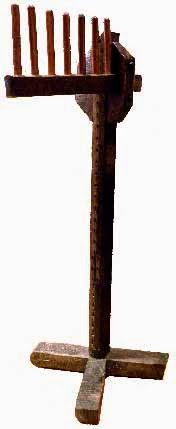It's hard to believe that within recent memory the bustling town of Bridport was the centre of an industry stretching back a thousand years or more - the manufacture of rope.
So synonymous did Bridport become with this product that in the 18C the hangman’s rope, was nicknamed 'The Bridport Dagger'.
So synonymous did Bridport become with this product that in the 18C the hangman’s rope, was nicknamed 'The Bridport Dagger'.
Why Bridport? The answer was simple; the surrounding area provided perfect conditions for the growing of flax and hemp, raw materials of the industry.
Written records of rope manufacture date back to the 12th C when King John placed large orders for rope and cordage for his navy. The industry though, is much older. Rope making and the production of sail cloth eventually employed more than half of Bridport's population while production methods changed very little until the late 19th C.
The manufacturing consisted of a number of quaintly named processes;
RETTING - After harvesting the flax was allowed to rot in ponds or the fields to separate the stems from the fibres.
SCALING - Stripping the hemp from the stems
BOLLING - The crushing of the stems to remove the woody parts. This was where the first mechanisation appeared; water mills were equipped part time with special hammers to pound the flax.
SCUTCHING or SWINGLING - This removed the crushed woody part.
HACKLING - Lengths of raw fibre were drawn though closely placed metal spikes like wire hairbrushes to make the fibres run in one direction. An arduous job, it was usually carried out by men.
SPINNING- Turned the raw flax into a quality of rope which became renowned throughout Britain; whether providing nets for the distant Newfoundland fisheries or the myriad lines and cables used on the Navy's wooden ships.
Spinning also gave Bridport its distinctive layout. Behind the small cottages still lining the high street are long, narrow alleys, now gardens. They provided the Rope Walks where the the rope was 'spun'; a process which until the mid-nineteenth century was carried out by hand usually by women and children.
At one end of the walk stood a simple wooden building called a turnhouse which housed the reel on which the completed twine was wound. This was usually turned by a child (often as young as six) sitting in a pit. Women, gradually fed out hanks of flax or hemp fastened around their waists, the ends attached to the spinning wheel, as they moved backwards away from the turn house. The newly made rope was supported at intervals by being hooked over upright posts known as skirders. It was a process that was carried out rain or shine, often far into the night when the women would fix a candle to each shoulder to light the work
From the rope industry net making arose; nets were braided using the twine in a process rather like knitting on a large scale using a braiding needle.
As with any industry, demand was fickle. The Navy eventually found it was cheaper to spin its own rope closer to its dockyards; luckily demand was replaced by the growth of the East India Company, while the Newfoundland fisheries (almost entirely fished by west of England men) created an ever-growing demand for nets. Towards the 19th C the rope-making processes were gradually brought together in mills. It was to be many years, though, before the use of outworkers was abandoned. In the last hundred years the industry became concentrated into of the hands of Gundrys founded by Jacob Gundry in 1665. Gundry's is now a multi million pound company part of a much bigger organisation Marmon Holdings who still market nets from Joseph Gungry's original works.
Written records of rope manufacture date back to the 12th C when King John placed large orders for rope and cordage for his navy. The industry though, is much older. Rope making and the production of sail cloth eventually employed more than half of Bridport's population while production methods changed very little until the late 19th C.
The manufacturing consisted of a number of quaintly named processes;
RETTING - After harvesting the flax was allowed to rot in ponds or the fields to separate the stems from the fibres.
SCALING - Stripping the hemp from the stems
BOLLING - The crushing of the stems to remove the woody parts. This was where the first mechanisation appeared; water mills were equipped part time with special hammers to pound the flax.
SCUTCHING or SWINGLING - This removed the crushed woody part.
HACKLING - Lengths of raw fibre were drawn though closely placed metal spikes like wire hairbrushes to make the fibres run in one direction. An arduous job, it was usually carried out by men.
 |
| Rope spinning machine |
Spinning also gave Bridport its distinctive layout. Behind the small cottages still lining the high street are long, narrow alleys, now gardens. They provided the Rope Walks where the the rope was 'spun'; a process which until the mid-nineteenth century was carried out by hand usually by women and children.
 |
| Ropewalk |
 |
| A skirder used to support the rope as it was spun |
From the rope industry net making arose; nets were braided using the twine in a process rather like knitting on a large scale using a braiding needle.
As with any industry, demand was fickle. The Navy eventually found it was cheaper to spin its own rope closer to its dockyards; luckily demand was replaced by the growth of the East India Company, while the Newfoundland fisheries (almost entirely fished by west of England men) created an ever-growing demand for nets. Towards the 19th C the rope-making processes were gradually brought together in mills. It was to be many years, though, before the use of outworkers was abandoned. In the last hundred years the industry became concentrated into of the hands of Gundrys founded by Jacob Gundry in 1665. Gundry's is now a multi million pound company part of a much bigger organisation Marmon Holdings who still market nets from Joseph Gungry's original works.
 |
| Net making |


No comments:
Post a Comment